Unit3《Australia》Integrating skills课件2(新人教版选修9)
文档属性
| 名称 | Unit3《Australia》Integrating skills课件2(新人教版选修9) | 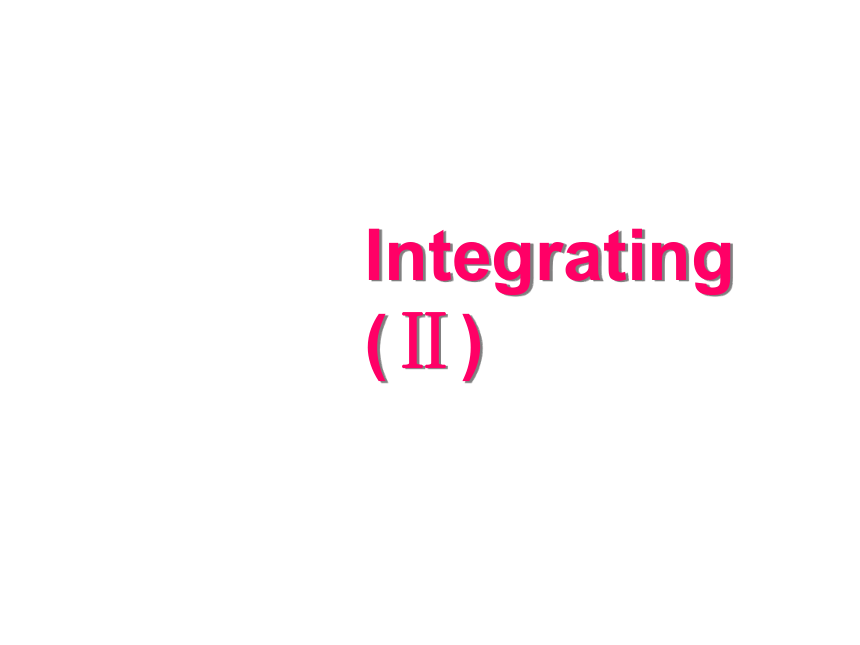 | |
| 格式 | rar | ||
| 文件大小 | 1.4MB | ||
| 资源类型 | 教案 | ||
| 版本资源 | 人教版(新课程标准) | ||
| 科目 | 英语 | ||
| 更新时间 | 2011-05-12 10:58:12 | ||
图片预览

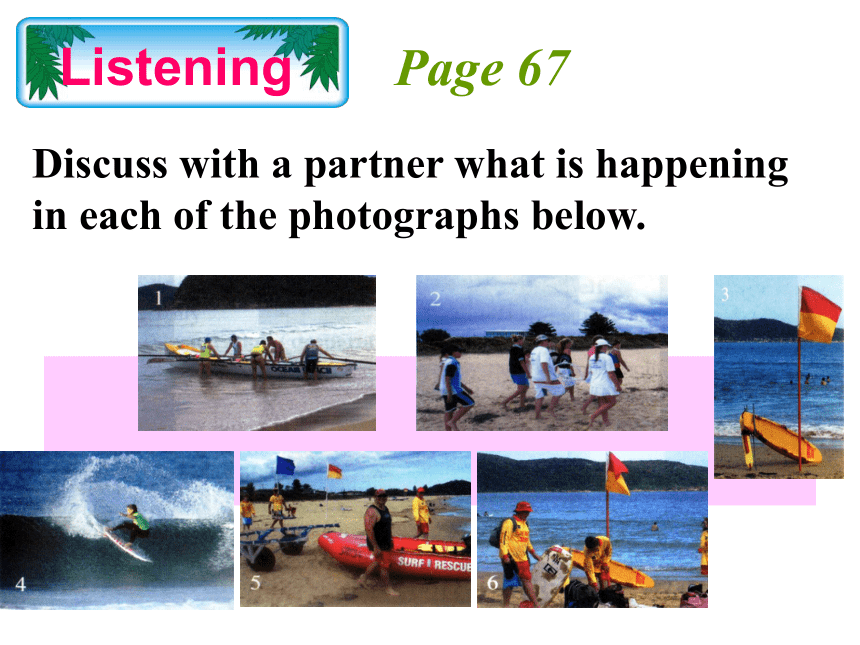
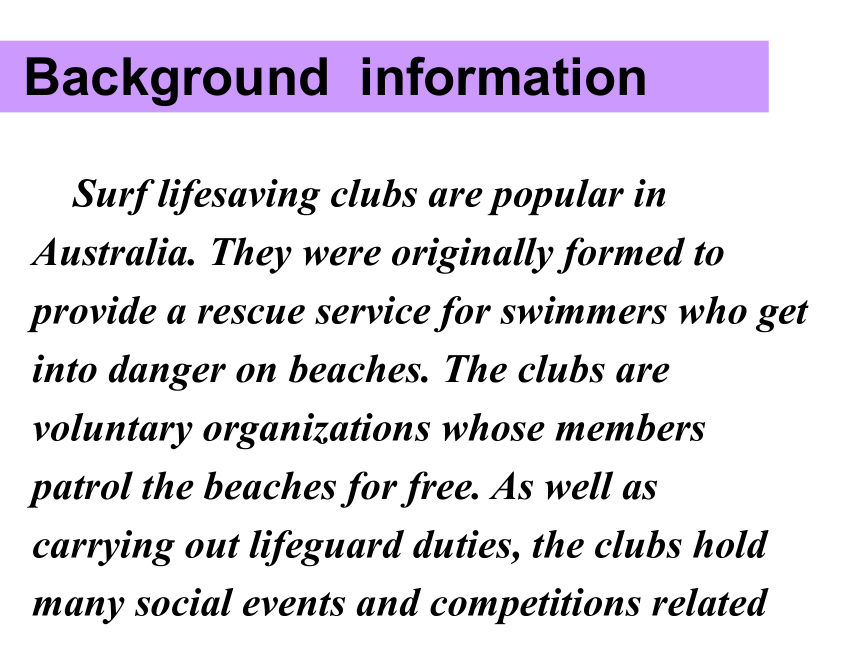

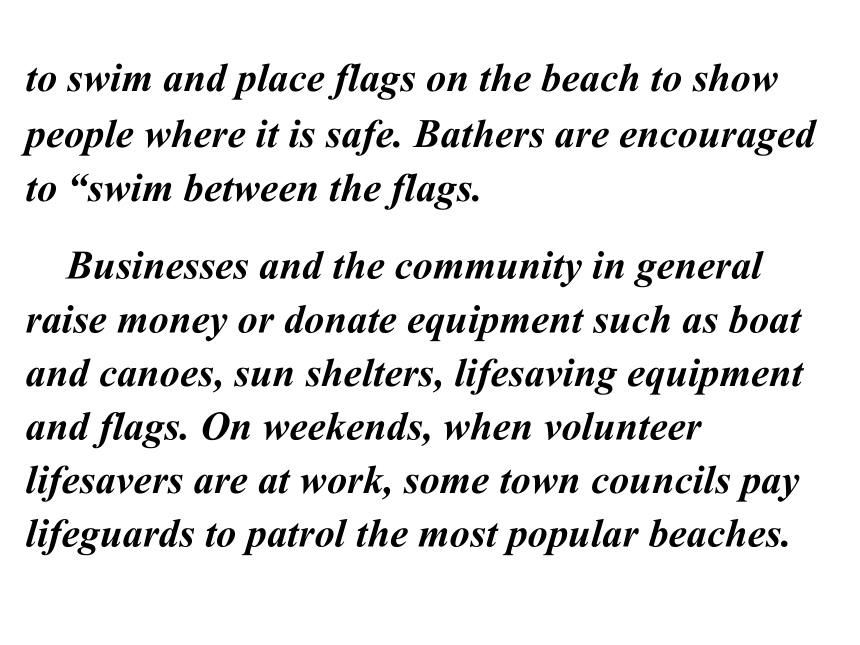
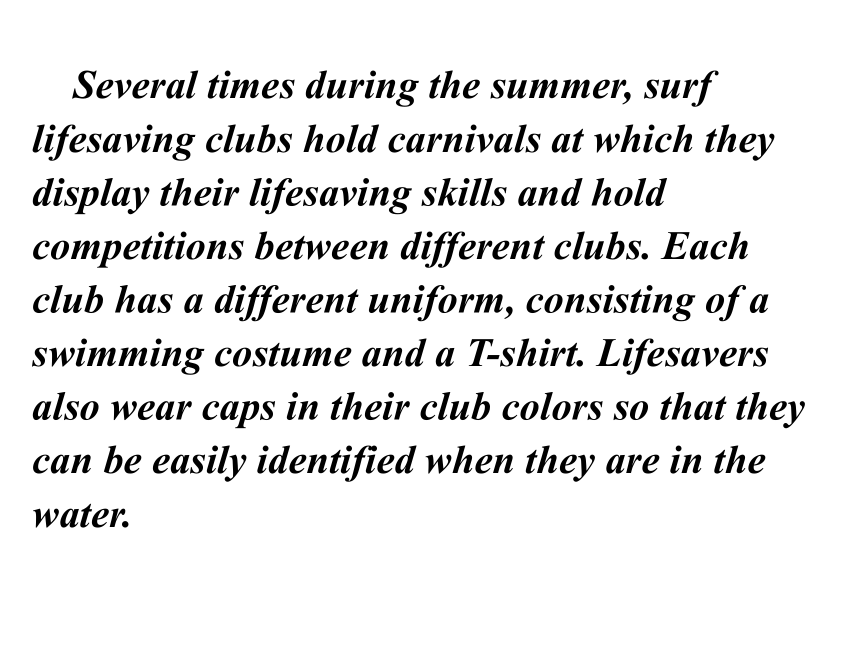
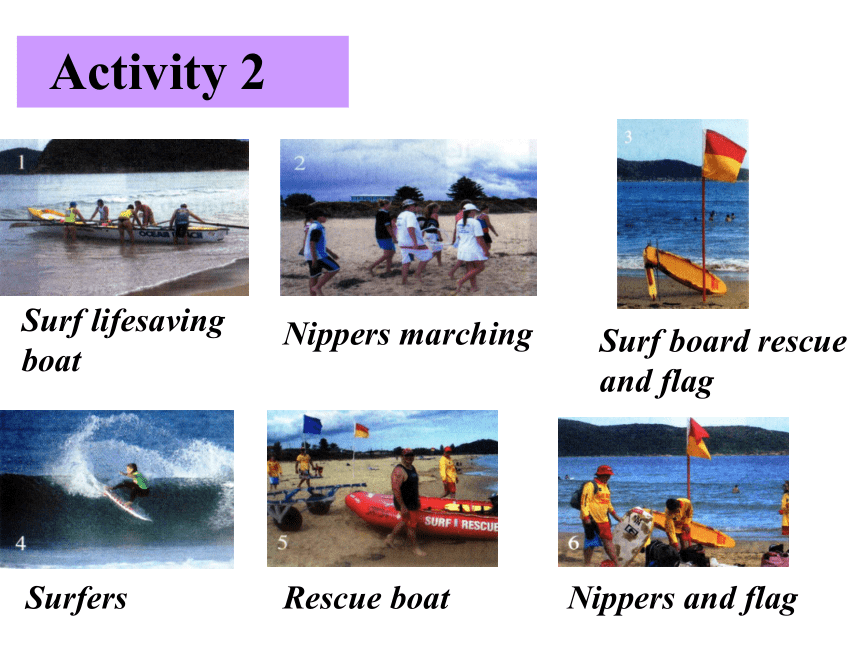
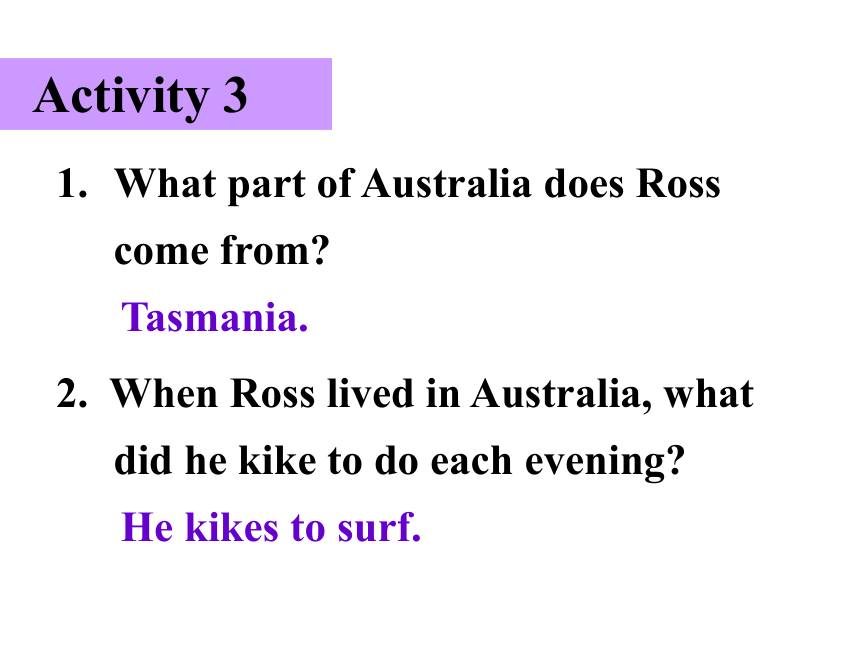
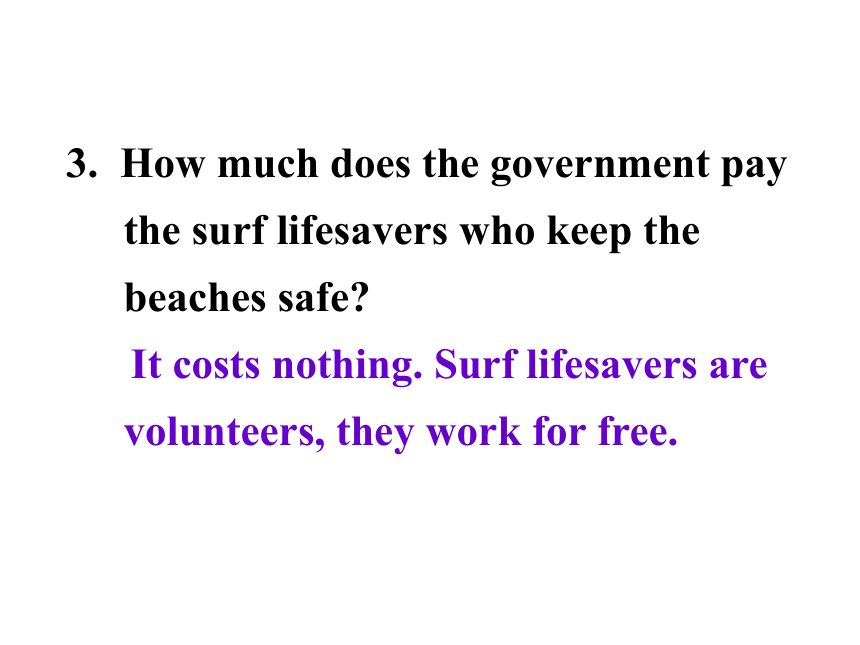
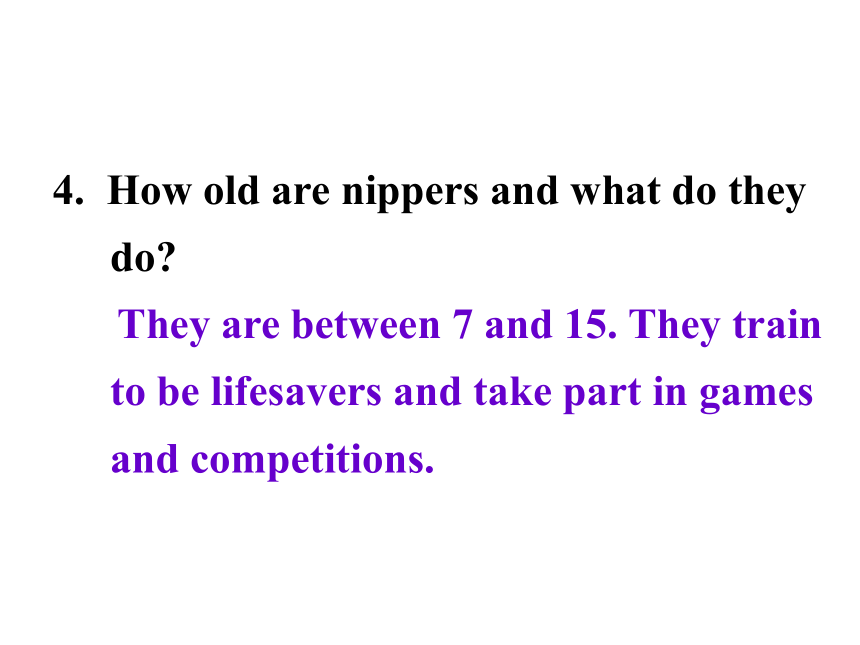
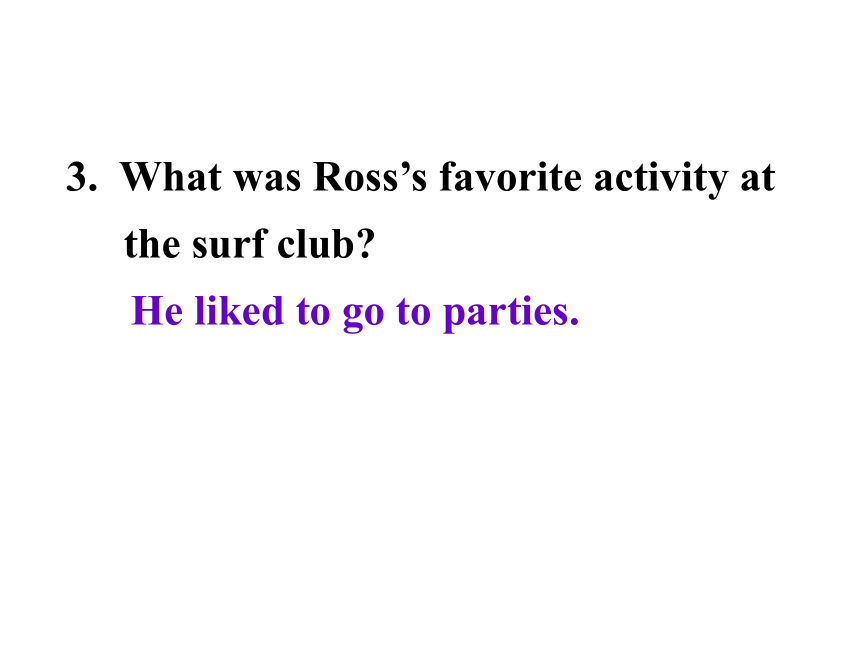
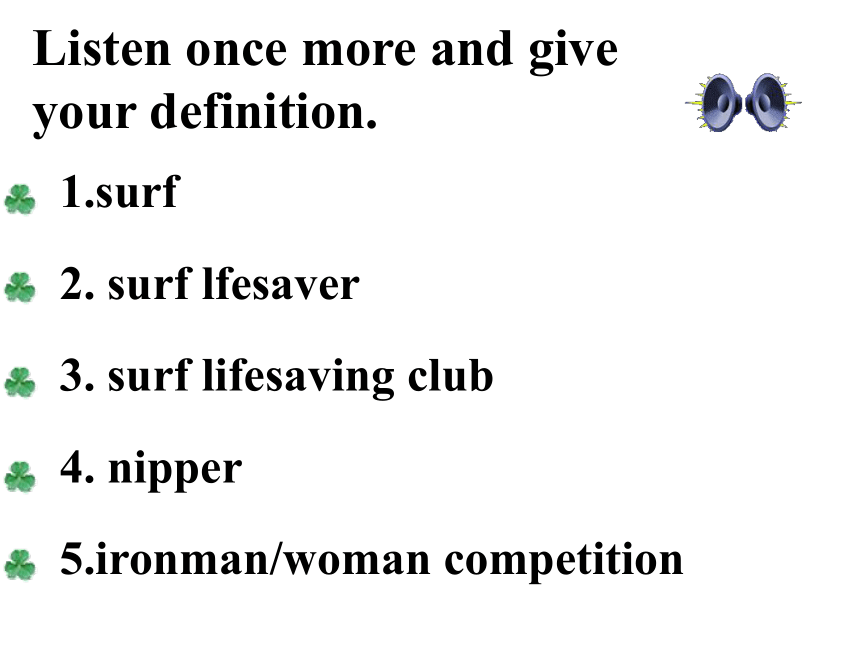
文档简介
(共51张PPT)
Integrating (Ⅱ)
Listening Page 67
Discuss with a partner what is happening in each of the photographs below.
Surf lifesaving clubs are popular in Australia. They were originally formed to provide a rescue service for swimmers who get into danger on beaches. The clubs are voluntary organizations whose members patrol the beaches for free. As well as carrying out lifeguard duties, the clubs hold many social events and competitions related
Background information
to the beach and swimming. Children between 7 and 15 can join as junior members, called nippers. The club provides activities for junior members at weekends and in the holidays. They receive training in lifesaving as well as taking part in healthy exercise at the beach.
As much of Australia’s coastline can be dangerous for inexperienced swimmers, surf lifesavers determine the safest place for people
to swim and place flags on the beach to show people where it is safe. Bathers are encouraged to “swim between the flags.
Businesses and the community in general raise money or donate equipment such as boat and canoes, sun shelters, lifesaving equipment and flags. On weekends, when volunteer lifesavers are at work, some town councils pay lifeguards to patrol the most popular beaches.
Several times during the summer, surf lifesaving clubs hold carnivals at which they display their lifesaving skills and hold competitions between different clubs. Each club has a different uniform, consisting of a swimming costume and a T-shirt. Lifesavers also wear caps in their club colors so that they can be easily identified when they are in the water.
Surf lifesaving boat
Nippers marching
Surf board rescue and flag
Surfers
Rescue boat
Nippers and flag
Activity 2
Activity 3
What part of Australia does Ross come from
Tasmania.
2. When Ross lived in Australia, what did he kike to do each evening
He kikes to surf.
3. How much does the government pay the surf lifesavers who keep the beaches safe
It costs nothing. Surf lifesavers are volunteers, they work for free.
4. How old are nippers and what do they do
They are between 7 and 15. They train to be lifesavers and take part in games and competitions.
3. What was Ross’s favorite activity at the surf club
He liked to go to parties.
Listen once more and give your definition.
surf
surf lfesaver
surf lifesaving club
nipper
ironman/woman competition
surf (v.) : to ride the waves into the beach on a surf board; surf (n.) the waves in the sea that are close to the shore and have white foam on the top.
surf lifesaver: someone who rescue people who get in trouble in the waves
surf lifesaving club: a social and sports cub that patrols beaches to keep swimmers safe.
nipper: a junior member of a surf lifesaving club (between 7 and 15 years old)
ironman/woman competition: a competition of three different races--- a swim, a foot race and a paddling race in a canoe or on surf board.
Listening text
Carol (C) and Ross (R) both go to university
in England. They meet up after lectures one
day and decide to go for a coffee.
R: Ooh. That’s better. It was cold out
there ! Look there’s a table over there
by the fire.
C: Great. I’ll get the coffee and you grab
the table.
R: Thanks, Carol. I’ll get the next one.
C: Fine, so how do you like this cold.
R: Well, I come from Tasmania so I’m
used to cold winter weather. But it’s
summer over there at the moment and
I’d sure like to be there.
C: What would you be doing if you were
at home
R: I’d probably be heading down to the
beach. I go down there most evenings
to surf.
C: Oh, so you surf, do you.
R: Yeah. I’ve been surfing since I was a
nipper.
C: A what
R: Oh, sorry. That’s what we call junior
lifesavers back home.
C: (laughs) Hang on. What’s a junior
lifesaver .
R: Well, you know how we have lifesavers
on all our popular beaches
C: No, I didn’t know that. It must cost the
government a lot of money to put
lifesavers on so many beaches.
R: No. They are volunteers. It’s like a
sports cub. They train to save lives and
when they aren’t watching over the
people on the beach they have all sorts
of competitions with other clubs.
C: Like what
R: Well, they have surf lifeboats that they
go out to rescue people and at carnivals,
they race with boats from other clubs.
And then there are ironmenand women
competition.
C: I have seen them on television. It’s
three races, isn’t it A swim, a foot
race and a race paddling a canoe or a
surfboard.
R: Yes that’s right. Surf lifesaving clubs
also have lots of other competitions
and social events.
C: So nippers are the young surf lifesavers
R: Yeah. They’re between 7 and 15 They
are training to be lifesavers when they
are older, and they have all sorts of
games and competitions suitable for
their age group.
C: So were you eve an iron man
R: (laugh) Not me. I was too much into
having a good time at surf club parties.
C: Yes, I can imagine that…
Speaking & Listening
Pre- listening (Discussion) P71
Why do countries have flags
What can flags tell you about a country Think of some examples.
What does China’s national flag tell us
What other organizations do you know that have flags What do they use them for
Why do countries have flags
A flag usually stands as a symbol
for that country. It can remind people
of some important values the nation
holds or something of its history or
culture. It is used on official occasions to
identify the nation to the rest of the
world.
2. What can flags tell you about a country Think of some examples.
They can tell people about the nations,
history, values or culture. For example, the
stars on the US flag represent the states in
the union. The cross on the Greek flag
symbolizes Christianity. The maple leaf on
the Canadian flag is the national emblem
of Canada.
3. What does China’s national flag tell us
The red color in the Chinese National
flag stands for the revolution, while the
gold color of the stars signifies the dawn
of a new era over the land. The five stars
grouped together symbolize the unity of
the Chinese people under the leadership
of the Chinese communist party.
3. What other organizations do you know that have flags What do they use them for
Red Cross Society, the Olympic Games,
companies, etc.
What elements do several of the flags have in common
In what ways could these common elements be connected to Australia
Which flag is the official flag of Australia
What do you think the other flags are
June is giving a talk about Australian flags and what they tell people about the history and culture of Australia. Listen and write down the numbers of the flag in the order you hear about them.
listening
1 ________
2 ________
3 ________
4 ________
Note-taking
Australian flag:______________________ ____________________________________
Aboriginal flag:______________________ ____________________________________
Eureka flag:_________________________ ____________________________________
Kangaroo flag:_______________________ ____________________________________
Listening text
June is giving a talk about Australian flags
and what they tell people about about the
history and culture of Australia.
Good afternoon, everyone. My hobby is
collecting flags from all over the world. I love
flags for two reasons. The first is that they
are beautiful and the second is that you can
learn a lot about the culture and history of a
country by studying its flags. Today I’d like
to show you some Australian flags and discuss their significance. Now, this is one is the official Australian flag. It was chosen in 1901 following a competition to design a flag especially for Australia. Before that date Australia had the same flag as Great Britain. The British flag is now in the top left quarter of the Australian flag to remind people of Australia's historical ties with Great Britain. The five stars represent the Southern Cross
which is an important group of five stars in the Southern hemisphere. Navigators use the Southern Cross to show them the direction of the South Pole. The other big star under the British flag represents the six states and the combined territories of Australia.
This flag has been the official Aboriginal flag since 1995. The black in the top half of the flag symbolizes the Aboriginal people themselves, while the red at the bottom
symbolizes the earth and the Aboriginal people's spiritual connection to the earth. The yellow circle in the middle represents the sun, the giver of life. This next flag was first flown in 1854 at a place called Eureka where a group of gold miners rebelled against the government. The incident is seen by many as the beginning of the movement towards democracy in Australia. The five stars represents the Southern Cross and the light
blue background is believed to represent
the blue shirts that many of the gold miners wore. Although not an official flag, it is recognized and loved by most Australians.
This is another flag that you often see in Australia, especially at sporting events. The kangaroo is recognized as the unofficial animal emblem of Australia and green and gold are the colors worn by many Australian
sporting teams when they travel overseas.
The flag first became popular in 1983 when it was flown on Australia’s entry to the America’s cup --- a famous yacht race which Australia won that year.
Some people feel it s time to change Australia's official flag because it is no longer appropriate to have the British flag in the most important part of the flag. The other flags you see here were designed for a competition for a new flag but so far none have been accepted.
Speaking
In groups, discuss the four designs for a new flag. What does each of the new flags tell you about Australia Which one do you think is the best
In groups, discuss what symbols you would put on a flag for your school, Then design a suitable flag. Show your design to the rest of the class and explain it.
Talking Page 50
Discuss what does each signs mean. Use
expressions like:
You’re not allowed… You mustn’t …
You can/can’t … You have to…
You should… It’s OK to…
Be careful … Look out!
Reading task Page72
The computers at Susan’s school are all connected to each other and the school has an online notice board where students can ask questions and give their opinions. Susan posted a question about the discovery of Australia on the online board. Read the questions and what her fellow students replied.
Discovery of Australia
40,000 + years ago People from Asia settled in the place we now call Australia.
1421 Some people think a Chinese fleet led by Zheng He may have visited Australia
1606 A Dutch sea captain first mapped the north coast.
Discovery of Australia
1644 Abel Tasman made a map on which he combined all know land and guessed the rest.
1770 Captain Cook sailed up the east coast of the continent
1802 Mathew Flinders sailed around the continent, mapped in and called it Australia.
Discussion
Why do you think school children in Australia in the 1950s were told that Captain Cook discovered Australia
Captain Cook claimed the land for
Britain and as Australia was originally
settled by people form Britain, this is
the part of the history that they were
taught.
2. Why does Mary White think European explorers didn’t discover the Australian continent until the 17th century
Before 1644, explorers didn’t know they had found a continent. They just visited small parts of it.
3. Why does Nick chance think Chinese explorers reached the continent so much earlier
He read about Chinese explorers on the Internet.
4. Patrick Hall says that the ancestors of the Aborigines discovered Australia at least 40, 000 years ago. Why do you think the other children didn’t give this answer
They may have thought that Aborigines always lived on the continent so they didn’t think they discovered it.
5. Which of the student's answers do you agree with and why Remember , that you first need to decide what “ discovered” means and what “ Australia” mean.
Many possible answers will depend on how students interpret discovered and
Australia.
Homework
Since you’ve learned so much about
Australia in this Unit, choose several
aspects that you think are interesting
to write a report (e.g. its animals, plant,
scenery, cities, beaches, people, leisure
actives, history or something else).
Integrating (Ⅱ)
Listening Page 67
Discuss with a partner what is happening in each of the photographs below.
Surf lifesaving clubs are popular in Australia. They were originally formed to provide a rescue service for swimmers who get into danger on beaches. The clubs are voluntary organizations whose members patrol the beaches for free. As well as carrying out lifeguard duties, the clubs hold many social events and competitions related
Background information
to the beach and swimming. Children between 7 and 15 can join as junior members, called nippers. The club provides activities for junior members at weekends and in the holidays. They receive training in lifesaving as well as taking part in healthy exercise at the beach.
As much of Australia’s coastline can be dangerous for inexperienced swimmers, surf lifesavers determine the safest place for people
to swim and place flags on the beach to show people where it is safe. Bathers are encouraged to “swim between the flags.
Businesses and the community in general raise money or donate equipment such as boat and canoes, sun shelters, lifesaving equipment and flags. On weekends, when volunteer lifesavers are at work, some town councils pay lifeguards to patrol the most popular beaches.
Several times during the summer, surf lifesaving clubs hold carnivals at which they display their lifesaving skills and hold competitions between different clubs. Each club has a different uniform, consisting of a swimming costume and a T-shirt. Lifesavers also wear caps in their club colors so that they can be easily identified when they are in the water.
Surf lifesaving boat
Nippers marching
Surf board rescue and flag
Surfers
Rescue boat
Nippers and flag
Activity 2
Activity 3
What part of Australia does Ross come from
Tasmania.
2. When Ross lived in Australia, what did he kike to do each evening
He kikes to surf.
3. How much does the government pay the surf lifesavers who keep the beaches safe
It costs nothing. Surf lifesavers are volunteers, they work for free.
4. How old are nippers and what do they do
They are between 7 and 15. They train to be lifesavers and take part in games and competitions.
3. What was Ross’s favorite activity at the surf club
He liked to go to parties.
Listen once more and give your definition.
surf
surf lfesaver
surf lifesaving club
nipper
ironman/woman competition
surf (v.) : to ride the waves into the beach on a surf board; surf (n.) the waves in the sea that are close to the shore and have white foam on the top.
surf lifesaver: someone who rescue people who get in trouble in the waves
surf lifesaving club: a social and sports cub that patrols beaches to keep swimmers safe.
nipper: a junior member of a surf lifesaving club (between 7 and 15 years old)
ironman/woman competition: a competition of three different races--- a swim, a foot race and a paddling race in a canoe or on surf board.
Listening text
Carol (C) and Ross (R) both go to university
in England. They meet up after lectures one
day and decide to go for a coffee.
R: Ooh. That’s better. It was cold out
there ! Look there’s a table over there
by the fire.
C: Great. I’ll get the coffee and you grab
the table.
R: Thanks, Carol. I’ll get the next one.
C: Fine, so how do you like this cold.
R: Well, I come from Tasmania so I’m
used to cold winter weather. But it’s
summer over there at the moment and
I’d sure like to be there.
C: What would you be doing if you were
at home
R: I’d probably be heading down to the
beach. I go down there most evenings
to surf.
C: Oh, so you surf, do you.
R: Yeah. I’ve been surfing since I was a
nipper.
C: A what
R: Oh, sorry. That’s what we call junior
lifesavers back home.
C: (laughs) Hang on. What’s a junior
lifesaver .
R: Well, you know how we have lifesavers
on all our popular beaches
C: No, I didn’t know that. It must cost the
government a lot of money to put
lifesavers on so many beaches.
R: No. They are volunteers. It’s like a
sports cub. They train to save lives and
when they aren’t watching over the
people on the beach they have all sorts
of competitions with other clubs.
C: Like what
R: Well, they have surf lifeboats that they
go out to rescue people and at carnivals,
they race with boats from other clubs.
And then there are ironmenand women
competition.
C: I have seen them on television. It’s
three races, isn’t it A swim, a foot
race and a race paddling a canoe or a
surfboard.
R: Yes that’s right. Surf lifesaving clubs
also have lots of other competitions
and social events.
C: So nippers are the young surf lifesavers
R: Yeah. They’re between 7 and 15 They
are training to be lifesavers when they
are older, and they have all sorts of
games and competitions suitable for
their age group.
C: So were you eve an iron man
R: (laugh) Not me. I was too much into
having a good time at surf club parties.
C: Yes, I can imagine that…
Speaking & Listening
Pre- listening (Discussion) P71
Why do countries have flags
What can flags tell you about a country Think of some examples.
What does China’s national flag tell us
What other organizations do you know that have flags What do they use them for
Why do countries have flags
A flag usually stands as a symbol
for that country. It can remind people
of some important values the nation
holds or something of its history or
culture. It is used on official occasions to
identify the nation to the rest of the
world.
2. What can flags tell you about a country Think of some examples.
They can tell people about the nations,
history, values or culture. For example, the
stars on the US flag represent the states in
the union. The cross on the Greek flag
symbolizes Christianity. The maple leaf on
the Canadian flag is the national emblem
of Canada.
3. What does China’s national flag tell us
The red color in the Chinese National
flag stands for the revolution, while the
gold color of the stars signifies the dawn
of a new era over the land. The five stars
grouped together symbolize the unity of
the Chinese people under the leadership
of the Chinese communist party.
3. What other organizations do you know that have flags What do they use them for
Red Cross Society, the Olympic Games,
companies, etc.
What elements do several of the flags have in common
In what ways could these common elements be connected to Australia
Which flag is the official flag of Australia
What do you think the other flags are
June is giving a talk about Australian flags and what they tell people about the history and culture of Australia. Listen and write down the numbers of the flag in the order you hear about them.
listening
1 ________
2 ________
3 ________
4 ________
Note-taking
Australian flag:______________________ ____________________________________
Aboriginal flag:______________________ ____________________________________
Eureka flag:_________________________ ____________________________________
Kangaroo flag:_______________________ ____________________________________
Listening text
June is giving a talk about Australian flags
and what they tell people about about the
history and culture of Australia.
Good afternoon, everyone. My hobby is
collecting flags from all over the world. I love
flags for two reasons. The first is that they
are beautiful and the second is that you can
learn a lot about the culture and history of a
country by studying its flags. Today I’d like
to show you some Australian flags and discuss their significance. Now, this is one is the official Australian flag. It was chosen in 1901 following a competition to design a flag especially for Australia. Before that date Australia had the same flag as Great Britain. The British flag is now in the top left quarter of the Australian flag to remind people of Australia's historical ties with Great Britain. The five stars represent the Southern Cross
which is an important group of five stars in the Southern hemisphere. Navigators use the Southern Cross to show them the direction of the South Pole. The other big star under the British flag represents the six states and the combined territories of Australia.
This flag has been the official Aboriginal flag since 1995. The black in the top half of the flag symbolizes the Aboriginal people themselves, while the red at the bottom
symbolizes the earth and the Aboriginal people's spiritual connection to the earth. The yellow circle in the middle represents the sun, the giver of life. This next flag was first flown in 1854 at a place called Eureka where a group of gold miners rebelled against the government. The incident is seen by many as the beginning of the movement towards democracy in Australia. The five stars represents the Southern Cross and the light
blue background is believed to represent
the blue shirts that many of the gold miners wore. Although not an official flag, it is recognized and loved by most Australians.
This is another flag that you often see in Australia, especially at sporting events. The kangaroo is recognized as the unofficial animal emblem of Australia and green and gold are the colors worn by many Australian
sporting teams when they travel overseas.
The flag first became popular in 1983 when it was flown on Australia’s entry to the America’s cup --- a famous yacht race which Australia won that year.
Some people feel it s time to change Australia's official flag because it is no longer appropriate to have the British flag in the most important part of the flag. The other flags you see here were designed for a competition for a new flag but so far none have been accepted.
Speaking
In groups, discuss the four designs for a new flag. What does each of the new flags tell you about Australia Which one do you think is the best
In groups, discuss what symbols you would put on a flag for your school, Then design a suitable flag. Show your design to the rest of the class and explain it.
Talking Page 50
Discuss what does each signs mean. Use
expressions like:
You’re not allowed… You mustn’t …
You can/can’t … You have to…
You should… It’s OK to…
Be careful … Look out!
Reading task Page72
The computers at Susan’s school are all connected to each other and the school has an online notice board where students can ask questions and give their opinions. Susan posted a question about the discovery of Australia on the online board. Read the questions and what her fellow students replied.
Discovery of Australia
40,000 + years ago People from Asia settled in the place we now call Australia.
1421 Some people think a Chinese fleet led by Zheng He may have visited Australia
1606 A Dutch sea captain first mapped the north coast.
Discovery of Australia
1644 Abel Tasman made a map on which he combined all know land and guessed the rest.
1770 Captain Cook sailed up the east coast of the continent
1802 Mathew Flinders sailed around the continent, mapped in and called it Australia.
Discussion
Why do you think school children in Australia in the 1950s were told that Captain Cook discovered Australia
Captain Cook claimed the land for
Britain and as Australia was originally
settled by people form Britain, this is
the part of the history that they were
taught.
2. Why does Mary White think European explorers didn’t discover the Australian continent until the 17th century
Before 1644, explorers didn’t know they had found a continent. They just visited small parts of it.
3. Why does Nick chance think Chinese explorers reached the continent so much earlier
He read about Chinese explorers on the Internet.
4. Patrick Hall says that the ancestors of the Aborigines discovered Australia at least 40, 000 years ago. Why do you think the other children didn’t give this answer
They may have thought that Aborigines always lived on the continent so they didn’t think they discovered it.
5. Which of the student's answers do you agree with and why Remember , that you first need to decide what “ discovered” means and what “ Australia” mean.
Many possible answers will depend on how students interpret discovered and
Australia.
Homework
Since you’ve learned so much about
Australia in this Unit, choose several
aspects that you think are interesting
to write a report (e.g. its animals, plant,
scenery, cities, beaches, people, leisure
actives, history or something else).
